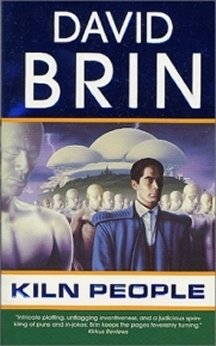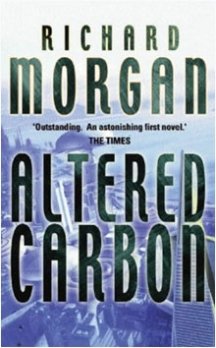

|
<<< Continued from previous page
Interestingly, murder mysteries are central plot elements in two of the most recent and important SF novels to feature technology-based consciousness transfers. The mystery format conveniently furnishes a central character who spends a lot of time asking questions and uncovering hidden truths, which in turn effectively advances the plot while also filling in the reader on the back-story. And perhaps the murder mystery format works so well because this technology fundamentally changes the very definition of murder, rendering any number of traditional motives and methods obsolete and opening the door for creating brand new ones. But on a more fundamental level, copying and transferring consciousness calls into question the very nature of personal identity. If the technology exists to create multiple identical me's, then who the heck am I? In Kiln People (New York: TOR, 2002; $5-), David Brin presents a world where technology allows anyone to use a home copier to transfer a ditto of himself into one or more disposable clay "golems." And in the truest form of multi-tasking yet depicted in SF, these dittos can then be sent off to run errands, clean house, study at the library or spend the day at work before uploading their distinct memories back to the original at the end of the day.

At one point, Brin writes of the time after the transference occurs, just before the narrative "I" learns if he is the consciousness inhabiting the original organic body, or the copy housed in a clay ditto with a maximum life of 24 hours. For that split second, the two identities are indistinguishable. Private detective Albert Morris is hired to investigate the disappearance of Universal Kilns' co-founder Yasil Maharal, the genius inventor of ditto technology. Morris's main clue is a ditto of Maharal that is fast approaching its 24-hour expiration time. Could Maharal's disappearance be linked to vague rumors of new breakthroughs in ditto technology? Kiln People is a fascinating story that almost requires the invention of a new literary term to describe the narrative point of view as it jumps from Morris to that of his two dittos - "first person multiple"? In Richard Morgan's Altered Carbon (London: Gollancz, 2002; $200+) (New York: Del Rey/Ballantine, 2002; SFBC, only US HB edition; $50+), five hundred years into the future the technology exists to copy and store the mind. This copy can then be uploaded into a new body (or sleeve), either locally, halfway around the world, or light years away on another planet. The technology is not cheap, but sufficient money can buy an implanted cortical hardware stack that continuously updates, along with periodic transmissions of backups to secure data warehouses. In the event of death (or instead of a face lift), the latest backup can be re-sleeved into a clone grown to any desired age. For the privileged, death has become little more than a minor inconvenience with at most a few hours of lost memories - equivalent perhaps to suffering a mild concussion with a little retrograde amnesia.

Takeshi Kovacs, former UN Envoy (highly trained Special Forces-types), is serving a prison sentence in off-line storage, his body killed during the course of his arrest. He awakens 180 light years away, on old Earth, hired as a private investigator by the extremely wealthy Laurens Bancroft. Kovacs has been hired to investigate Bancroft's death - the police have closed the case as suicide - but Bancroft insists that he was murdered. What follows is a remarkable exploration of the technology and its philosophical, cultural, political, economic, and religious implications. Somehow, it also manages to be hugely entertaining as it seamlessly blends hard-boiled pulp detective with far-future SF. Small, telling touches make this story really work. For example, the former occupant of the body Kovacs is sleeved into was a smoker, and through the story Kovacs finds himself reflexively reaching for cigarettes and suffering from nicotine withdrawal. See also the sequel, Broken Angels (London,: Gollancz, 2003; $25). Morgan describes this as a "deeper and darker excursion into the Kovacs universe." Robert Sawyer presents a well-received turn on this theme in his newest book, Mindscan (New York: Tor, 2005; $10 - $15). In a world where you can copy your consciousness into an android body, there is no reason to continue living in an organic body wasting away from a terminal disease or one in a state of advanced age. Jake Sullivan elects to undergo the mindscan technique with the provision that his organic self must live out the short remainder of his life in exile on the moon. Meanwhile, his android self carries on with a happy life on Earth, even meeting and falling in love with Karen, another uploaded android whose original body has already died of old age. But everything changes when a miracle cure is discovered that can restore Jake to full health and Karen's organic son files a lawsuit claiming that his mother died with her organic body and the android Karen has no rights to keep him from his inheritance. Much of the "action" in this book takes place in a courtroom, but there is plenty of drama as Sawyer tackles some tough questions head on. See also Sawyer's novella "Identity Theft," where technology to download humans into organic/mechanical bodies (transfers) has opened up a new world of possibilities in crime, including putting a literal spin on the term identity theft. Greg Egan is another author who has written key titles exploring this theme. In his so-called jewel-head stories, Egan investigates critical questions related to a technology in which an individual's consciousness is "learned" by a piece of nearly indestructible hardware (the jewel) implanted in the head at birth. The final switchover to hardware-based consciousness occurs at age 18, culminating in the removal of the individual's organic brain. In these stories, Egan's style is reminiscent of the way Asimov used the short story to probe the boundaries of robot technology, concurrently grappling with similar issues of identity, humanity, and consciousness. In "Learning to be Me" (first collected in Axiomatic [London.: Millennium. 1995; $100]), the question of existence is complicated when a jewel-consciousness begins to diverge from its organic original, leading to two similar but distinctly different identities, one of which will "die" at age 18. Which one is real, and does either have more of a right to life than the other? See also Egan's Permutation City (London: Millenium, 1994; $150+) and Diaspora (London: Millenium, 1997; $15). A Note on UK Editions: Greg Egan's Permutation City is a good example of something that the serious book collector and seller should be aware of in UK publishing. Some publishers (Millenium among them) will print at least two versions of the dust jacket for their trade hardbacks, one with and one without the price. The ones without the price are intended for the export market, primarily Australia, Canada, etc. In other words, the first printing exists with two states of the DJ, but they are still both first printings. One state might be preferred over another, but this is not entirely clear to me at this time. Tip: it is possible to pick up significantly under priced export first printings of desirable titles, if the seller mistakes the unpriced copy for a book club edition.
< to previous article
Questions or comments?
| Forum
| Store
| Publications
| BookLinks
| BookSearch
| BookTopics
| Archives
| Advertise
| AboutUs
| ContactUs
| Search Site
| Site Map
| Google Site Map
Store - Specials
| BookHunt
| BookShelf
| Gold Edition & BookThink's Quarterly Market Report
| DomainsForSale
| BookThinker newsletter - free
Copyright 2003-2011 by BookThink LLC
|

|